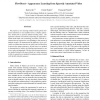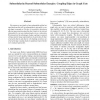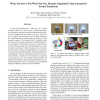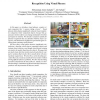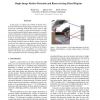125
Voted
CVPR
2011
IEEE
14 years 7 months ago
2011
IEEE
We propose a new learning method which exploits temporal consistency to successfully learn a complex appearance model from a sparsely labeled training video. Our approach consists...
168
Voted
CVPR
2011
IEEE
14 years 7 months ago
2011
IEEE
We propose a new family of non-submodular global energy functions that still use submodularity internally to couple edges in a graph cut. We show it is possible to develop an efï¬...
142
Voted
CVPR
2011
IEEE
14 years 7 months ago
2011
IEEE
Recent work in structure from motion (SfM) has successfully built 3D models from large unstructured collections of images downloaded from the Internet. Most approaches use increme...
139
Voted
CVPR
2011
IEEE
14 years 7 months ago
2011
IEEE
In real-world applications, âwhat you sawâ during training is often not âwhat you getâ during deployment: the distribution and even the type and dimensionality of features...
130
click to vote
CVPR
2011
IEEE
14 years 7 months ago
2011
IEEE
In this paper we introduce visual phrases, complex visual composites like âa person riding a horseâ. Visual phrases often display signiï¬cantly reduced visual complexity comp...
126
Voted
CVPR
2011
IEEE
14 years 7 months ago
2011
IEEE
In this paper, we address the problem of shadow detection and removal from single images of natural scenes. Different from traditional methods that explore pixel or edge informati...
135
Voted
CVPR
2011
IEEE
14 years 7 months ago
2011
IEEE
In this paper, we exploit a novel ranking mechanism that processes query samples with noisy labels, motivated by the practical application of web image search re-ranking where the...
148
click to vote
CVPR
2011
IEEE
14 years 7 months ago
2011
IEEE
This paper presents a complete solution to estimating a sceneâs 3D geometry and appearance from multiple 2D images by using a statistical inverse ray tracing method. Instead of ...
121
Voted
CVPR
2011
IEEE
14 years 7 months ago
2011
IEEE
We address the problem of ï¬nding deformation between two images for the purpose of recognizing objects. The challenge is that discriminative features are often transformation-va...
106
Voted
CVPR
2011
IEEE
14 years 7 months ago
2011
IEEE
Datasets are an integral part of contemporary object recognition research. They have been the chief reason for the considerable progress in the ï¬eld, not just as source of large...
